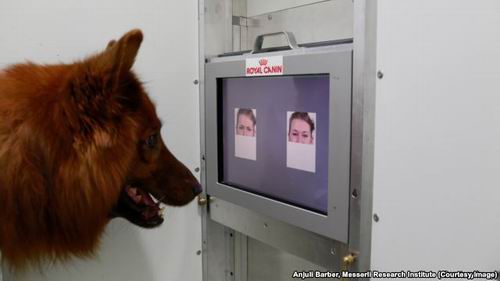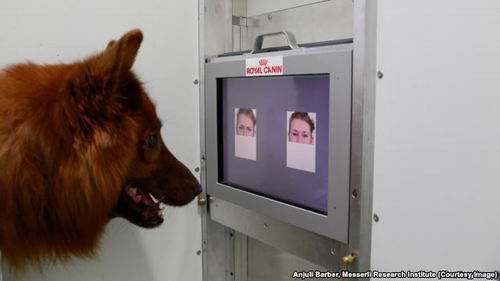VOA慢速英语: 狗可以识别人的感受
- 参考译文
- 听力原文
Dogs Can Recognize How You Feel
 |
|
A dog considers which face is happy and which is angry. |
狗能够识别人的感受
So you think you know your dog. But how well does your dog know you? She probably recognizes you when she sees you. But can a dog tell by simply looking at you whether you have a happy or an angry expression on your face? Researchers in Austria have taught pet dogs to know the difference.
你认为自己了解狗,但是你的狗狗了解你多少呢?狗狗看见你的时候或许会知道你的感受。但是狗能不能单单通过看你脸上的喜悦表情或者生气表情就判断你不同的感受呢?奥地利研究员教给宠物狗辨别情绪的不同。
Dogs are very mindful of sound. When dog owners shout or speak in a strong, harsh voice, dogs often act guilty and quietly move away from the area.
狗对声音很敏感。当狗主人用一种大嗓门对狗叫喊或者说话时,狗通常会乖乖地、悄悄地离开。
Recently, researchers found that dogs can look at our faces, and tell the difference between a smile and a frown. The animals were able to recognize a look of approval from one of disapproval.
最近,研究者发现狗可以通过看我们的脸,辨别出来微笑与皱眉之间的不同。也能够区别人同意与不同意时的表情神色。
Researchers at the University of Veterinary Medicine, Vienna performed a series of experiments. They taught dogs to recognize facial expressions. They showed the dogs two pictures of either the upper or lower half of a person's face. On one picture, the person looked happy. The other appeared angry.
奥地利维也纳动物医学院的研究员进行了一系列的试验,他们让狗去识别面部表情。给狗展示两张半张脸:一张上半张脸,一张下半张脸;一张脸开心,另一张脸生气。
The dogs were then shown images of the eyes or mouths of people they had never seen before. They were also shown the left half of the faces used in training.
然后给狗看它们从未见过的人的眼睛或嘴的图像。在训练的过程中,给它们展示的是左半边脸。
Corsin Muller led the study.
卡森·穆勒主导这项研究。
"We were essentially speaking, do they realize that smiling eyes have the same meaning as a smiling mouth, or angry eyes have the same meaning as an angry mouth? And it turned out that they really did perform very well in these probe trials. Once they had learned the initial discrimination, they could spontaneously, immediately choose the correct one also in the probe trials with the normal stimuli."
“从根本上讲,狗能够明白眼睛微笑时也代表嘴在微笑吗?或者眼神怒气冲冲代表嘴也怒气冲冲吗?实验结果表明它们在这些试验调查中,确实表现不错。一旦学会初步的鉴别后,一点外界的刺激,它们就能够本能地、立刻找出那个正确的那个。”
Once the dogs learned to recognize which image was happy or angry, they could easily identify the same expressions in pictures of any face.
一旦狗狗学会辨别哪个形象是开心或生气,它们能够很容易地确认图片中任何一张有类似表情的脸。
Corsin Muller says future studies will try to show whether dogs can learn the meaning of facial expressions -- for example, whether a frown shows that someone is angry.
卡森·穆勒说未来的研究会尝试证明狗是否能够学会面部表情代表的意义——比如:是否皱眉表明某人生气。
"What we can say with our study is that they can discriminate them, that they can tell these ones are different. But what we cannot be sure of at this point is what exact meaning they are associating with these different expressions.”
“我们的研究想要说明的是:狗能够鉴别人类的表情,它们可以辨别出来表情的差异。但是我们不能确认的是它们看到这些不同的表情后的联想到的意义是什么。”
“Seems of course likely that they would associate some positive meaning with the smiley face and they would associate some rather negative meaning with the angry face. But what exactly they are associating with these expressions we cannot know at this point."
“很有可能它们把一些积极的意思跟微笑的脸相联系,把一些消极的意思跟愤怒的表情相联系。但是它们到底把这些表情跟什么相联系我们目前不得而知。”
In the experiments, researchers found the dogs were slower to link a reward, or prize, with recognition of the angry face. This suggested that dogs had an idea people with angry faces were best avoided.
试验中,研究者发现狗在把获奖与识别愤怒的表情之间联系时,它们的反应慢。这表明狗明白:人在生气时,它们最好还是离开。
Corsin Muller says canine investigators are also interested in finding out whether wild wolves can be trained to recognize human facial expressions.
卡森·穆勒表示犬类调查者同样对找出野狼是否也能够被训练来识别人类面部表情感兴趣。
The researchers’ findings were published in the journal Current Biology. They provide the first solid evidence that humans are not the only species that can read the body language of another species.
研究者的这一发现发表在《当代生物学》杂志上。这一发现提供确凿证据:人类并不是唯一能够辨别其他物种身体语言的物种。
I’m Marsha James.
我是玛莎·詹姆斯。
VOA’s Jessica Berman prepared this report. Marsha James wrote it forLearning English. George Grow was the editor.
_____________________________________________________________
Words in This Story
probe - n., a careful examination or investigation of something
stimulus – n., something that causes something else to happen, develop, orbecome more active
avoid – v., to stay away from (someone or something)
Dogs Can Recognize How You Feel
 |
|
A dog considers which face is happy and which is angry. |
So you think you know your dog. But how well does your dog know you? She probably recognizes you when she sees you. But can a dog tell by simply looking at you whether you have a happy or an angry expression on your face? Researchers in Austria have taught pet dogs to know the difference.
Dogs are very mindful of sound. When dog owners shout or speak in a strong,harsh voice, dogs often act guilty and quietly move away from the area.
Recently, researchers found that dogs can look at our faces, and tell the difference between a smile and a frown. The animals were able to recognize a look of approval from one of disapproval.
Researchers at the University of Veterinary Medicine, Vienna performed a series of experiments. They taught dogs to recognize facial expressions. They showed the dogs two pictures of either the upper or lower half of a person's face. On one picture, the person looked happy. The other appeared angry.
The dogs were then shown images of the eyes or mouths of people they had never seen before. They were also shown the left half of the faces used in training.
Corsin Muller led the study.
"We were essentially speaking, do they realize that smiling eyes have the same meaning as a smiling mouth, or angry eyes have the same meaning as an angry mouth? And it turned out that they really did perform very well in these probe trials. Once they had learned the initial discrimination, they could spontaneously, immediately choose the correct one also in the probe trials with the normal stimuli."
Once the dogs learned to recognize which image was happy or angry, they could easily identify the same expressions in pictures of any face.
Corsin Muller says future studies will try to show whether dogs can learn the meaning of facial expressions -- for example, whether a frown shows that someone is angry.
"What we can say with our study is that they can discriminate them, that they can tell these ones are different. But what we cannot be sure of at this point is what exact meaning they are associating with these different expressions.”
“Seems of course likely that they would associate some positive meaning with the smiley face and they would associate some rather negative meaning with the angry face. But what exactly they are associating with these expressions we cannot know at this point."
In the experiments, researchers found the dogs were slower to link a reward, or prize, with recognition of the angry face. This suggested that dogs had an idea people with angry faces were best avoided.
Corsin Muller says canine investigators are also interested in finding out whether wild wolves can be trained to recognize human facial expressions.
The researchers’ findings were published in the journal Current Biology. Theyprovide the first solid evidence that humans are not the only species that canread the body language of another species.
I’m Marsha James.
VOA’s Jessica Berman prepared this report. Marsha James wrote it forLearning English. George Grow was the editor.
_____________________________________________________________
Words in This Story
probe - n., a careful examination or investigation of something
stimulus – n., something that causes something else to happen, develop, orbecome more active
avoid – v., to stay away from (someone or something)
- 频道推荐
- |
- 全站推荐
- 推荐下载
- 网站推荐




















